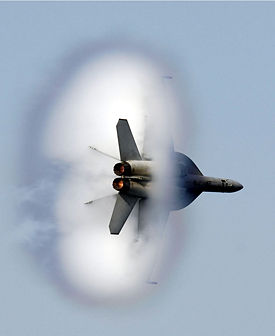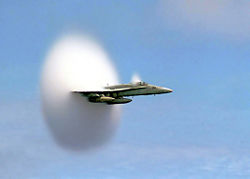Supersonic
- For other uses see Supersonic.
The term supersonic is used to define a speed that is over the speed of sound (Mach 1). At a typical temperature like 21 °C (70 °F), the threshold value required for an object to be traveling at a supersonic speed is approximately 344 m/s, (1,129 ft/s, 770 mph or 1,238 km/h). Speeds greater than 5 times the speed of sound are often referred to as hypersonic. Speeds where only some parts of the air around an object (such as the ends of rotor blades) reach supersonic speeds are labeled transonic (typically somewhere between Mach 0.8 and Mach 1.2).
Sounds are travelling vibrations (pressure waves) in an elastic medium. In gases sound travels longitudinally at different speeds, mostly depending on the molecular mass and temperature of the gas; (pressure has little effect). Since air temperature and composition varies significantly with altitude, Mach numbers for aircraft can change without airspeed varying. In water at room temperature supersonic can be considered as any speed greater than 1,440 m/s (4,724 ft/s). In solids, sound waves can be longitudinal or transverse and have even higher velocities. Supersonic fracture is crack motion faster than the speed of sound in a brittle material.
Supersonic objects
Most modern fighter aircraft are supersonic, but Concorde and the Tupolev Tu-144 were the only supersonic passenger aircraft. Since Concorde's final retirement flight on November 26 2003, there are no supersonic passenger aircraft left in service. Some large bombers, such as the Tupolev Tu-160 and Rockwell/Boeing B-1B are also supersonic-capable. An aircraft that can still sustain supersonic flight without using an afterburner is called a supercruise aircraft.
Most modern firearm munitions are supersonic, with rifle projectiles often travelling at speeds approaching Mach 3.
Most spacecraft, most notably the Space Shuttle are supersonic at least during portions of their reentry, though the effects on the spacecraft are reduced by low air pressures. During ascent, launch vehicles generally avoid going supersonic below 30 km (~98,400 feet) to reduce air drag.
Note that the speed of sound decreases somewhat with altitude, due to lower temperatures found there (typically up to 25 km). At even higher altitudes the temperature starts increasing, with the corresponding increase in the speed of sound.[3]
A wave traveling through a bull whip is also capable of achieving supersonic speeds. [4]
Breaking the sound barrier
In aerodynamics, the sound barrier usually refers to the point at which an aircraft moves from transonic to supersonic speed. The term came into use during World War II when a number of aircraft started to encounter the effects of compressibility, a grab-bag of unrelated aerodynamic effects. The term fell out of use in the 1950s when aircraft started to routinely "break" the sound barrier. Refer to the speed of sound for the science behind the velocity referred to as the sound barrier, and to sonic boom for information on the sound associated with supersonic flight. Chuck Yeager was the first man to achieve super sonic flight.
Supersonic flight
Supersonic aerodynamics are simpler than subsonic because the airsheets at different points along the plane often can't affect each other. Supersonic jets and rocket vehicles require several times greater thrust to push through the extra drag experienced within the transonic region (around Mach 0.85-1.2). At these speeds Aerospace engineers can gently guide air around the fuselage of the aircraft without producing new shock waves but any change in cross sectional area further down the vehicle leads to shock waves along the body. Designers use the Supersonic area rule and the Whitcomb area rule to minimize sudden changes in size.
It should be kept in mind, however, that the aerodynamic principles behind a supersonic aircraft are often more complex than described above because such an aircraft must be efficient and stable at supersonic, transonic and subsonic flight.
At high speeds aerodynamic heating can occur, so an aircraft must be designed to operate and function under very high temperatures. For example, the SR-71 Blackbird jet could fly continuously at Mach 3.1 while some parts were above 315°C (600°F).
See also
- Supersonic aerodynamics
- De Laval nozzle
- Jet engine intake design
- Jet engine nozzle
- Mach number
- Rocket engine nozzles
- Sonic boom
- Sound barrier
- the Right Stuff a movie about early supersonic pilots
- Supersonic area rule
- Whitcomb area rule
Other flow regimes
- Subsonic flows.
- Transonic flows.
- Hypersonic flows.
ReferencesISBN links support NWE through referral fees
External links
ca:Velocitat supersònica da:Supersonisk de:Überschallgeschwindigkeit et:Ülehelikiirus es:Velocidad supersónica eo:Supersona rapido fr:Supersonique id:Supersonik it:Regime supersonico nl:Supersonische snelheid ja:超音速 no:Supersonisk pl:Prędkość naddźwiękowa pt:Velocidade supersónica ro:Supersonic ru:Сверхзвуковая скорость simple:Supersonic sv:Överljudshastighet tr:Süpersonik zh:超音速

